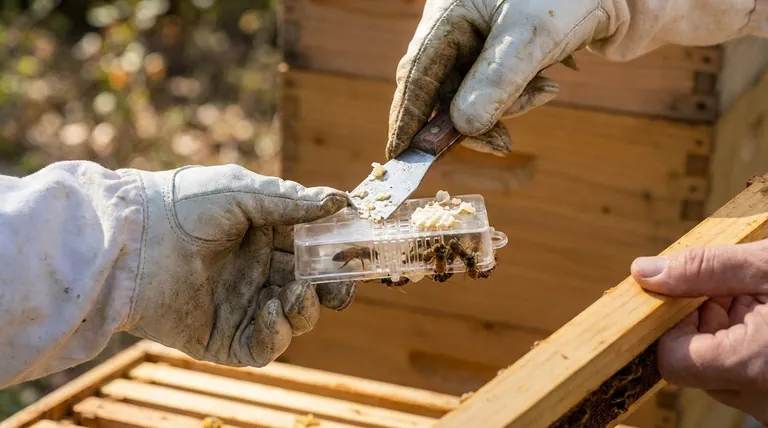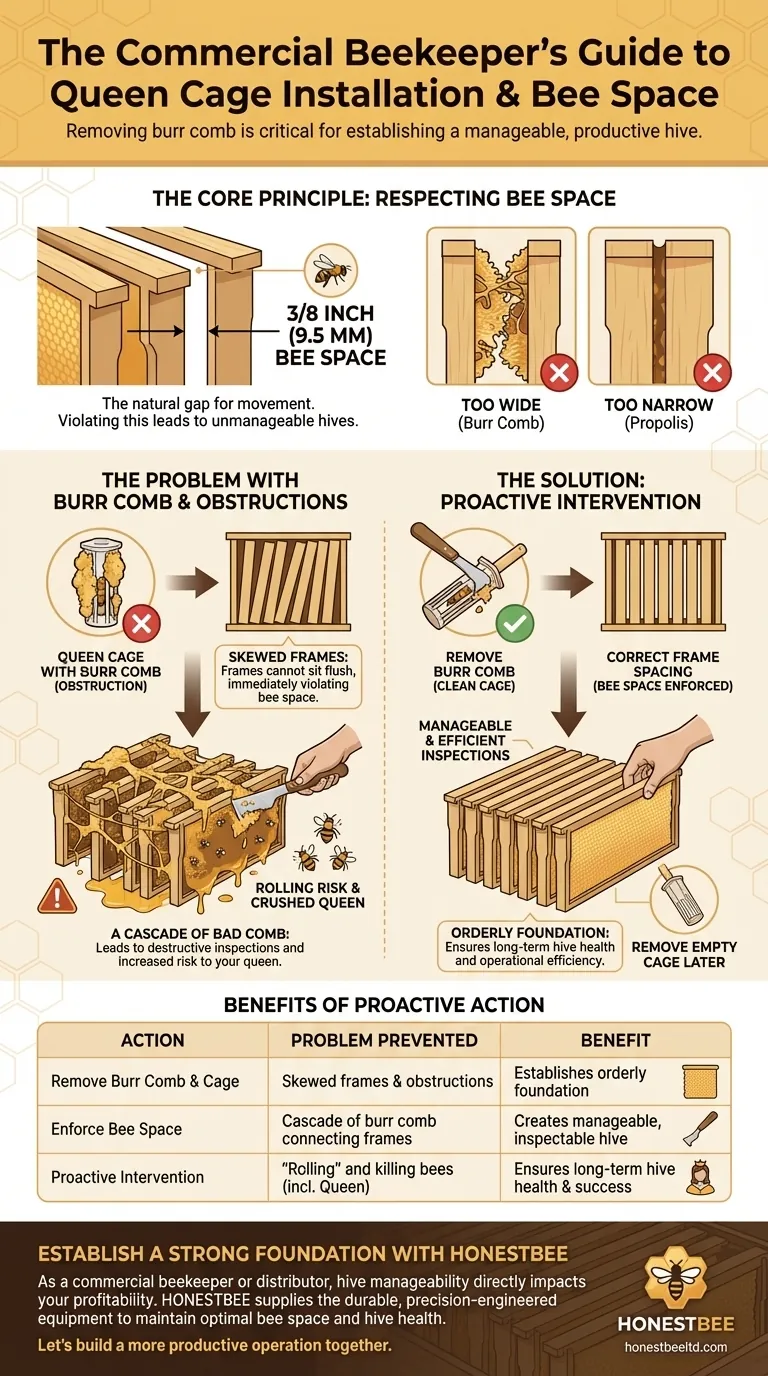Removing burr comb from a new queen cage is a critical first step for establishing a manageable and productive hive. This simple act ensures you can position your frames correctly, which dictates how your bees will build their comb and prevents significant problems during future inspections.
This task is not about simple tidiness. It is your first and most important opportunity to enforce the principle of "bee space," the foundational concept of modern beekeeping that allows you to work with your bees without destroying their home.

The Core Principle: Respecting Bee Space
Bee space is the single most important architectural principle inside a beehive. Your actions as a beekeeper must always work to preserve it.
What is Bee Space?
Bee space is the specific gap, approximately 3/8 of an inch (9.5 mm), that honey bees naturally leave between their combs. They keep this gap clear as a pathway to move throughout the hive.
Why It's So Important
When frames in a hive are spaced correctly, they create this ideal bee space between them. If the space is too wide, bees will fill the gap with extra comb called burr comb or brace comb. If the space is too narrow, they will seal it shut with propolis.
Both outcomes make the hive incredibly difficult to manage.
The Queen Cage as an Obstruction
When you install a new queen, the cage and any comb built on it act as a physical obstruction. This extra bulk prevents you from pushing the frames together to achieve the correct, even spacing.
The Consequences of Ignoring Burr Comb
Failing to remove this initial burr comb sets off a chain reaction that leads to a disorganized and difficult hive.
The Immediate Problem: Skewed Frames
The most obvious issue is that the extra comb physically prevents you from placing the frames flush against each other. This creates uneven gaps, immediately violating the principle of bee space.
The Long-Term Problem: A Cascade of Bad Comb
Bees are efficient builders. When they encounter an oversized gap between frames, they will instinctively fill it with burr comb. One section of bad comb encourages the next, leading to a tangled mess that connects frames together.
Creating a Difficult and Destructive Hive
A hive filled with burr and brace comb is a nightmare to inspect. When you try to pull out a frame, it will be stuck to its neighbors. You inevitably tear comb, spill honey and nectar, and crush brood.
Most importantly, this process significantly increases the risk of "rolling" and killing bees, including the possibility of accidentally crushing your queen.
Common Pitfalls to Avoid
New beekeepers often hesitate, fearing they are disrupting the colony. However, this is a necessary and beneficial intervention.
The Fear of "Bothering the Bees"
While minimizing disturbance is a good goal, removing burr comb is a proactive measure. The small, temporary disruption of removing the comb prevents the much larger, more destructive disruption of tearing apart a badly built hive later.
Forgetting to Remove the Cage
After the queen is released (typically in a few days), the empty queen cage must also be removed. It is also an obstruction that will disrupt bee space and encourage the construction of burr comb if left in the hive.
Making the Right Choice for Your Hive
Your goal is to guide your bees to build a home that is both productive for them and manageable for you.
- If your primary focus is establishing a healthy colony: Removing all obstructions sets the foundation for an orderly hive, allowing bees to work efficiently from day one.
- If your primary focus is easy and safe hive inspections: Enforcing bee space at installation is non-negotiable, as it prevents the comb-welded frames that make inspections destructive.
- If your primary focus is long-term hive success: Taking this small step correctly saves you from major structural problems down the line.
This small, deliberate action is a cornerstone of proactive and successful beekeeping.
Summary Table:
| Action | Problem Prevented | Benefit |
|---|---|---|
| Remove Burr Comb | Skewed frames and uneven bee space | Establishes a foundation for orderly comb building |
| Enforce Bee Space | Cascade of burr comb connecting frames | Creates a manageable, inspectable hive |
| Remove Empty Queen Cage | Future obstruction and comb building | Prevents destruction of brood/honey during inspections |
| Proactive Intervention | "Rolling" and killing bees, including the queen | Ensures long-term hive health and beekeeper success |
Establish a Strong Foundation for Your Apiary with HONESTBEE
As a commercial beekeeper or distributor, hive manageability directly impacts your operational efficiency and profitability. The simple act of correctly installing a queen by removing burr comb is a foundational practice for a productive operation.
At HONESTBEE, we supply the durable, precision-engineered equipment that commercial apiaries and distributors rely on to maintain optimal bee space and hive health. From durable hive tools for careful comb removal to well-spaced frames that encourage proper construction, our wholesale-focused operations are built to support your scale.
Let's build a more productive and manageable operation together.
Contact HONESTBEE today to discuss your wholesale equipment needs and ensure every hive starts right.
Visual Guide

Related Products
- Professional Multi-Functional Queen Bee Cage
- Durable Galvanized Steel Spring Queen Bee Cage
- Multi-Function Queen Roller Cage and Catcher
- Professional Multi-Compartment Queen Cage with Sliding Lid
- Professional Queen Cage with Sliding Gate and Feeder Plug
People Also Ask
- What is sequestration, and how does it help bees reorient? A Safer Guide to Hive Relocation
- What should be done if bees damage the queen cage or harm the queen? Rescue Your Queen and Save Your Hive
- How do you check if the queen has been released after installation? A Guide to Successful Queen Acceptance
- How long does it typically take bees to adjust to a new queen? Master the 2-7 Day Acceptance Window
- What should be done before removing the queen cage from the hive? Ensure Your New Queen is Accepted & Laying



















